Species Transport Training Package, Beginner Part 1, 10 Practical Exercises
$1,340.00 Original price was: $1,340.00.$219.00Current price is: $219.00. Student Discount
Species Transport ANSYS Fluent CFD Simulation Training Package for BEGINNER Users
Click on Add To Cart and obtain the Geometry file, Mesh file, and a Comprehensive ANSYS Fluent Training Video.To Order Your Project or benefit from a CFD consultation, contact our experts via email ([email protected]), online support tab, or WhatsApp at +44 7443 197273.
There are some Free Products to check our service quality.
If you want the training video in another language instead of English, ask it via [email protected] after you buy the product.
Description
Species Transport ANSYS Fluent CFD Simulation Training Package for BEGINNER Users
This training package includes 10 practical Species Transport exercises using ANSYS Fluent software. MR CFD suggests this package for BEGINNER users new to this module.
Pollution
Project number 1 simulates changes in the mass fraction of carbon dioxide on an urban street. a 0.1 m height area should be considered as a source of carbon dioxide pollutants on the street from the urban domain. The main purpose of the current simulation is to investigate the effect of free airflow on the amount of CO2 produced by car exhaust. Therefore, an integrated carbon-dioxide production area is defined as a source of mass production on a city street.
Project number 2 simulates the effects of the oil tank detonation process in an urban area and the pollutant emission. In fact, in areas with oil reservoirs, one of the potential dangers is explosion. The explosion of these oil tanks can lead to the release of many pollutants such as carbon dioxide into the environment. Suppose there are residential areas and industrial units around the oil reservoirs in the mentioned area. In that case, the spread of these pollutants from the explosion and their transfer to the surrounding environment can be very dangerous and affect people’s lives.
In project number 3, using the Species Transport module, the gases from combustion in the car engine and their interaction with the open air in the urban environment were investigated statically and in traffic mode. For this purpose, the exhaust gas velocity was equal to 1 m / s, and the temperature was 400 K for the static state. In the second case, with the same speed and temperature of the exhaust gas, an external flow with 3 m / s enters due to the car’s movement in traffic mode.
In project number 4, a combustion reaction is simulated inside a combustion chamber. In a gaseous state, the volatile coal mixture enters the combustion chamber and mixes with high-temperature airflow (1623 K). As a result, the combustion process takes place. This process will also result in different productions, including pollutants like NOx, SOx, etc., which will be analyzed in this project.
Combustion (Species Transport)
In project number 5, methane-air fuel mixture combustion inside a gas turbine combustion chamber is simulated. Methane and oxygen are injected inside the combustion chamber with a velocity of 128.9304m/s and 12.0396m/s and a temperature of 286K and 109K, respectively. The fuel mixture is then ignited and energy and heat are generated. The Energy model is activated. Also, the species transport model is used to analyze the combustion process.
Project number 6 simulates the combustion process of diesel fuel inside a combustion chamber of a gas turbine system. The function of the combustion chamber is such that the airflow enters the chamber from the space around the chamber and then passes through a diffuser duct with blades, becomes disturbed, and enters the special combustion space to better mix with the fuel.
In project number 7, a combustion reaction is simulated inside a vortex combustion chamber. The energy equation is activated. The k-epsilon Standard viscosity model is used to analyze the turbulence of the two-phase current and the standard wall function is exploited for the regions near the walls. The species transport model is used to analyze the combustion process.
Project number 8 simulates non-premixed combustion. In fact, a two-dimensional combustion chamber is designed in which airflow and fuel flow enter simultaneously from two different inlets with different flow rates. The combustion process occurs when some air is combined with some hydrocarbon fuel to convert fuel energy into heat energy. After the combustion process occurs, the products of chemical reactions leave the combustion chamber.
Ventilation
In project number 9, the operating room HVAC, considering the equipment and persons within it, including the doctor and patient, is simulated using an air conditioning system. The source of the contaminants and excess gases is assumed on the patient’s body. The inlet air moves from the top to the bottom of the operating room for the clearing process and transfers contaminated gases and particles around the patient to the room’s corners.
Engine Manifold (Species Transport)
In project number 10, steady airflow mixing with fuel is investigated in a 3-outlet manifold where only one outlet is effective and the other 2 outlets are blocked. Two inlets provide air and fuel flow into the domain. Air and fuel flow rates are equal to 0.2335 and 0.0374 kg/s. Species entering the domain via air inlet are nitrogen and oxygen with mass fractions equal to 0.79 and 0.21, respectively. Species entering the domain via fuel inlet are CO, CH4, CO2, N2, and H2 with mass fractions equal to 0.06, 0.004, 0.1, 0.081, and 0.03 respectively.
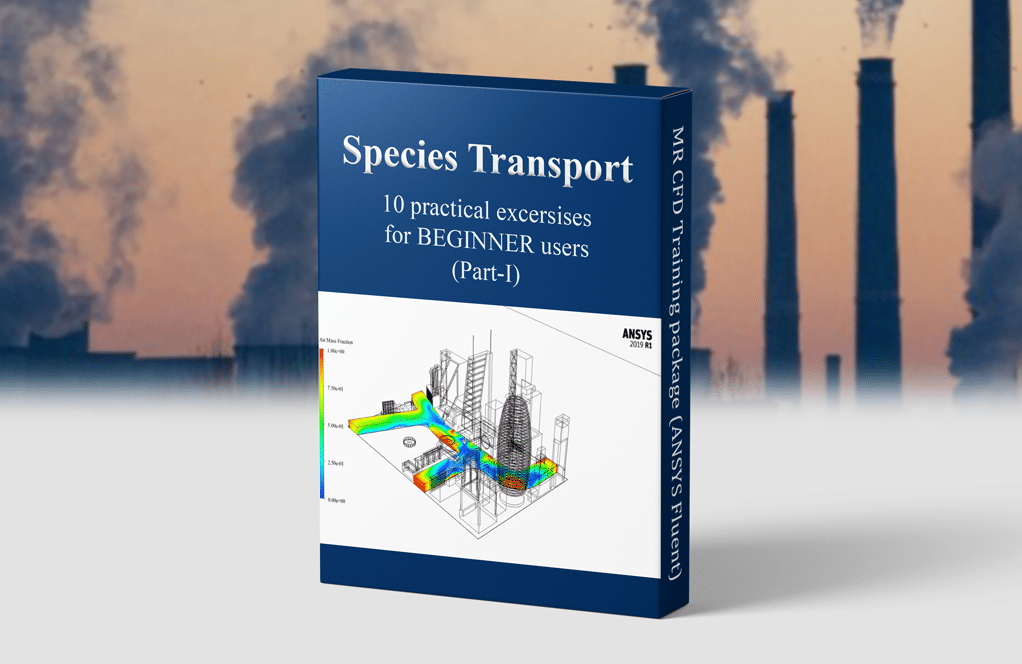


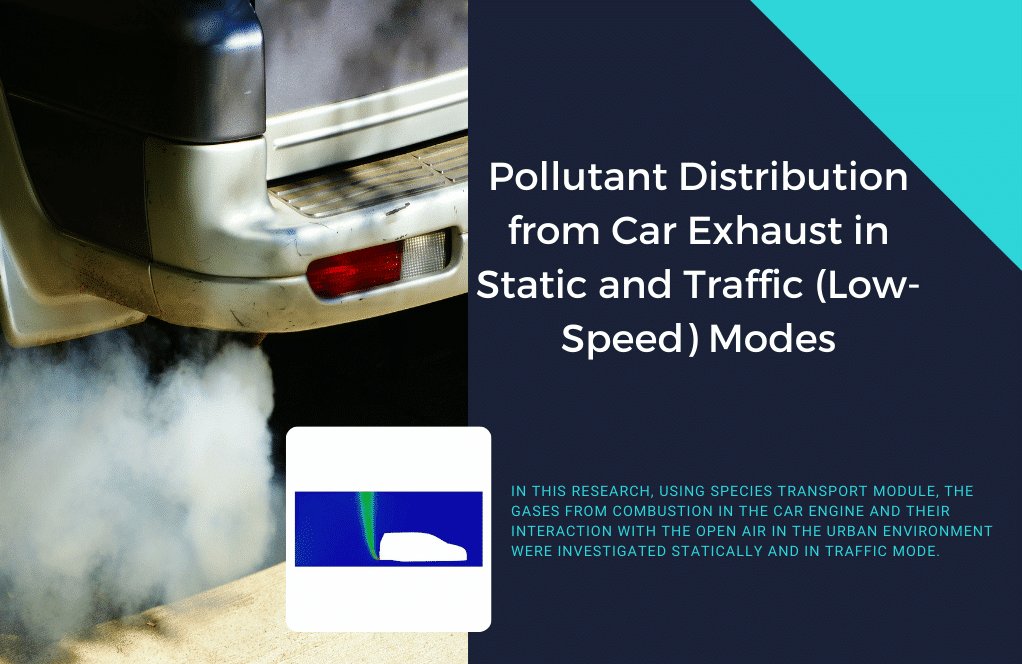
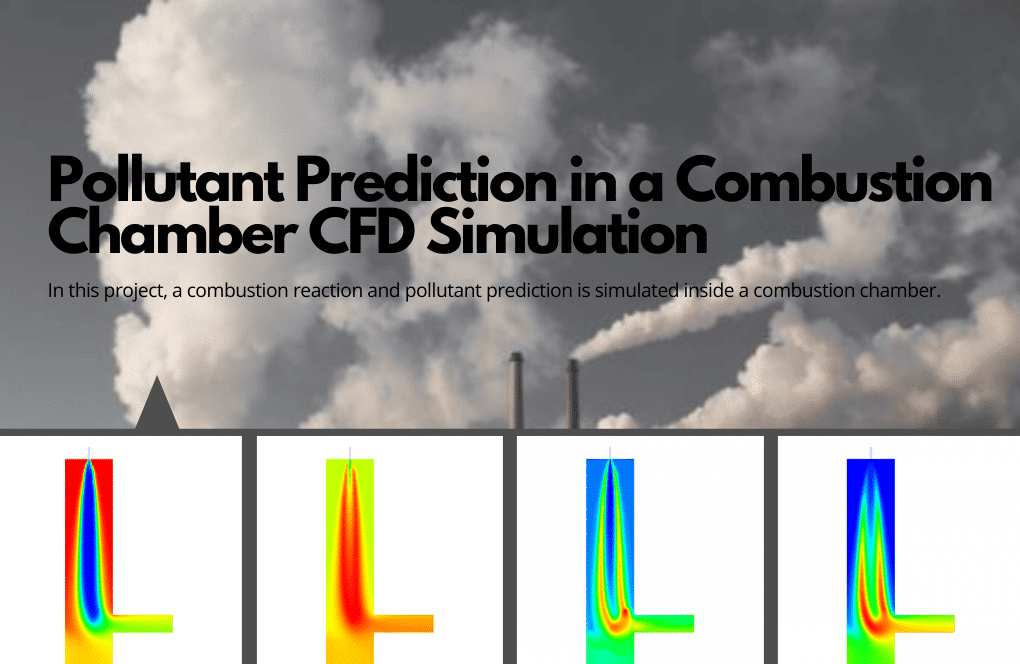
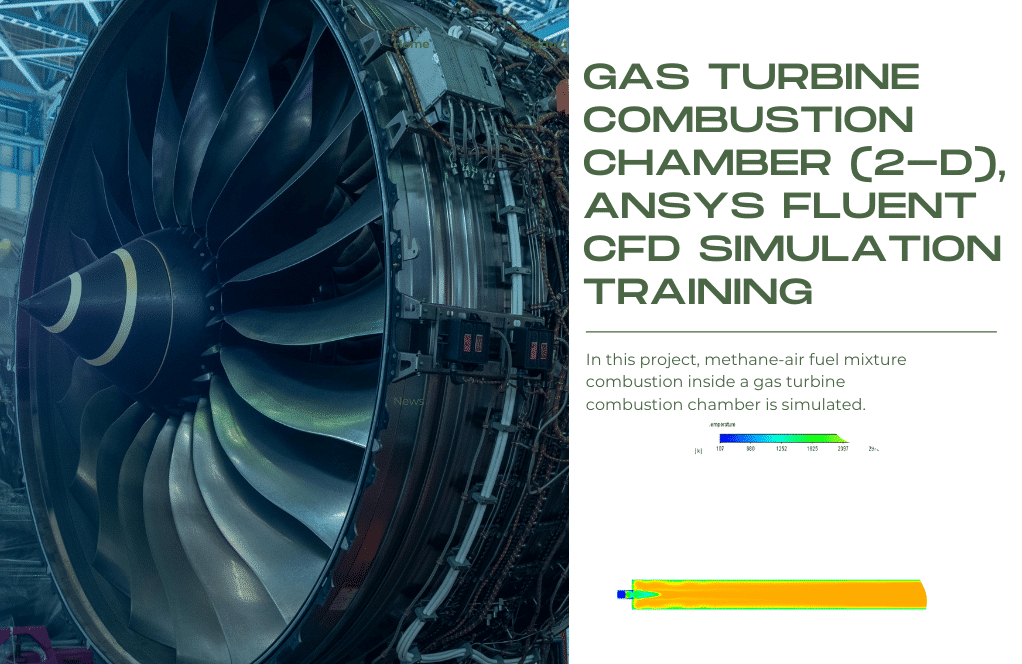
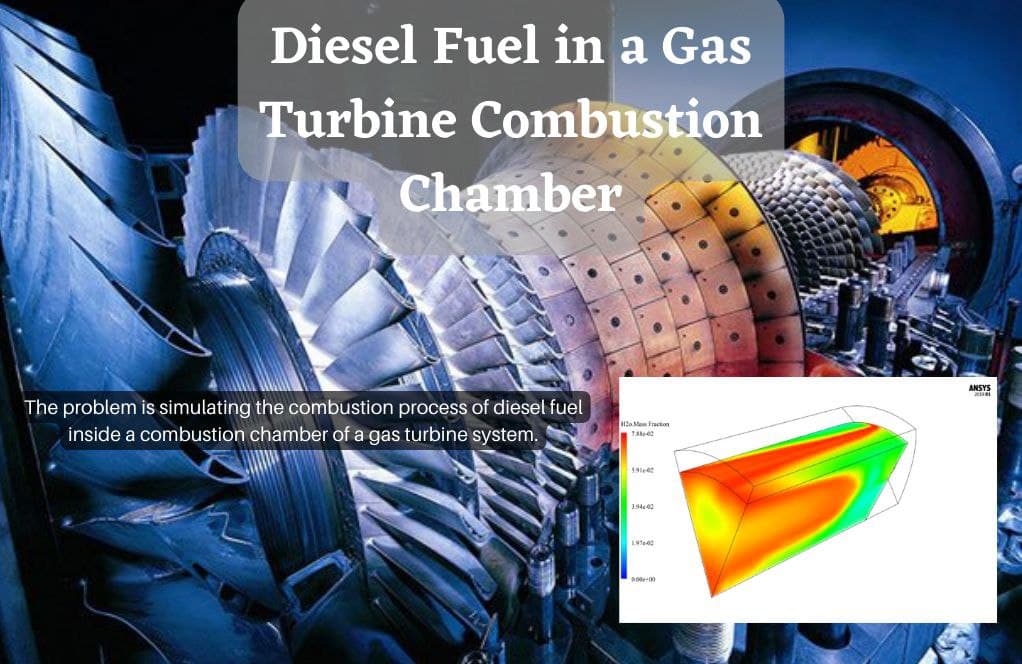
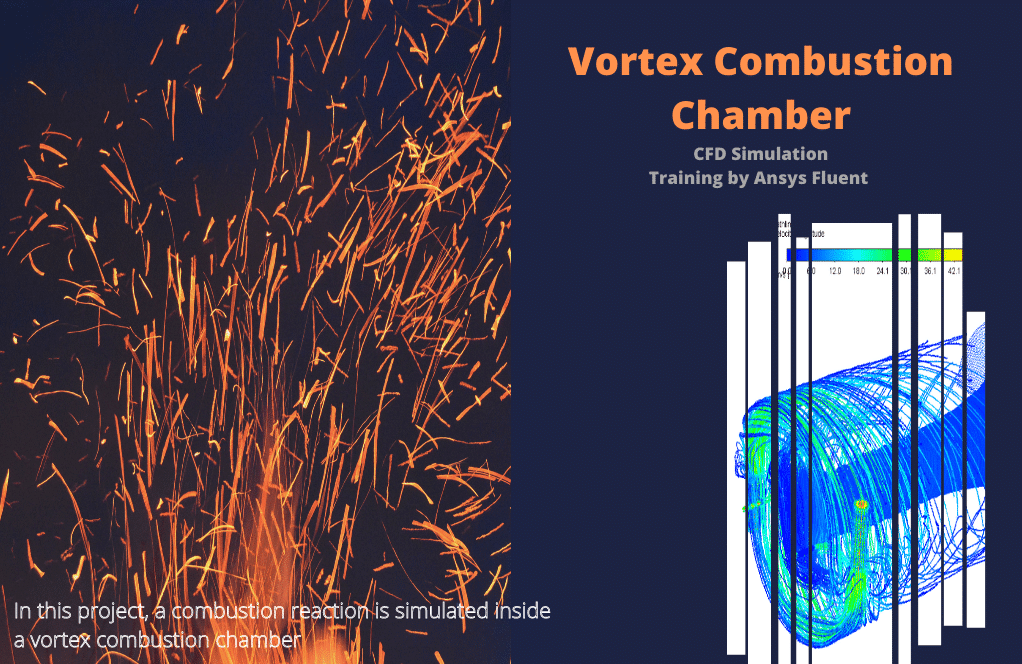
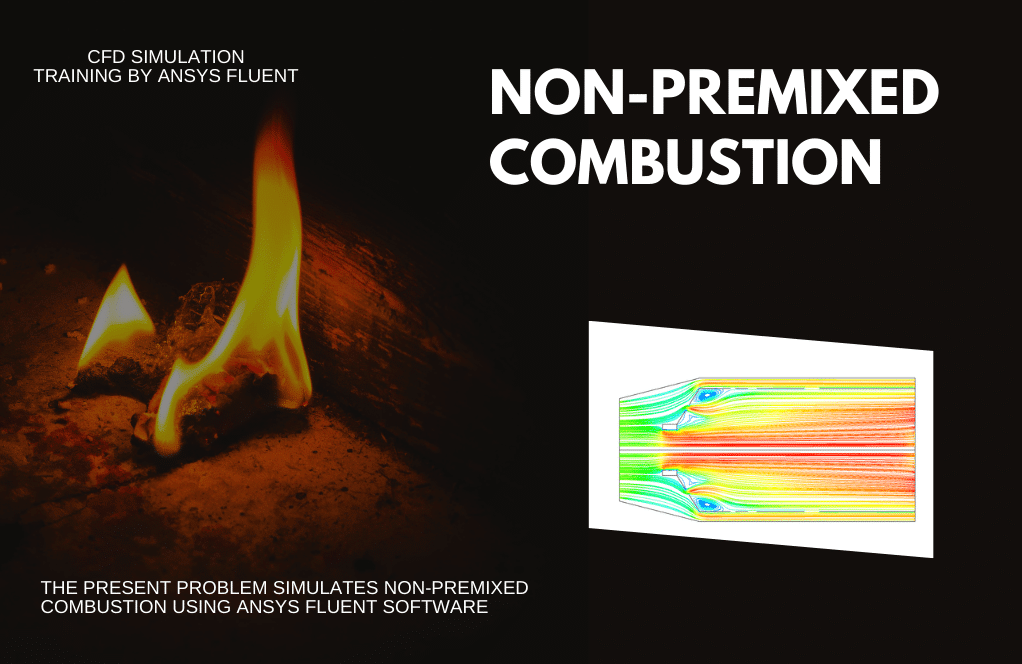
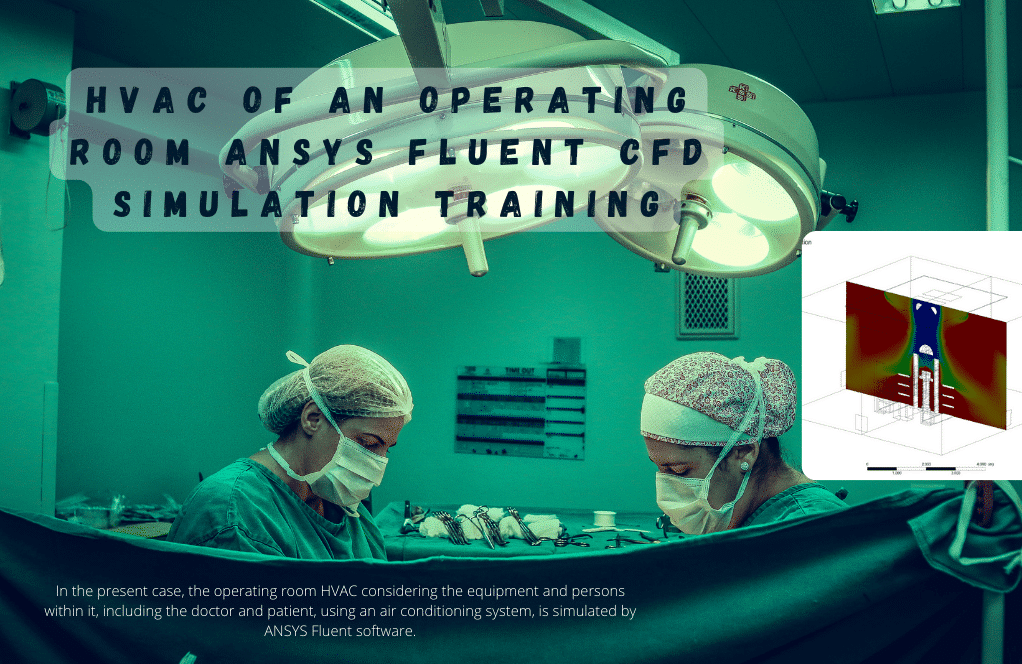
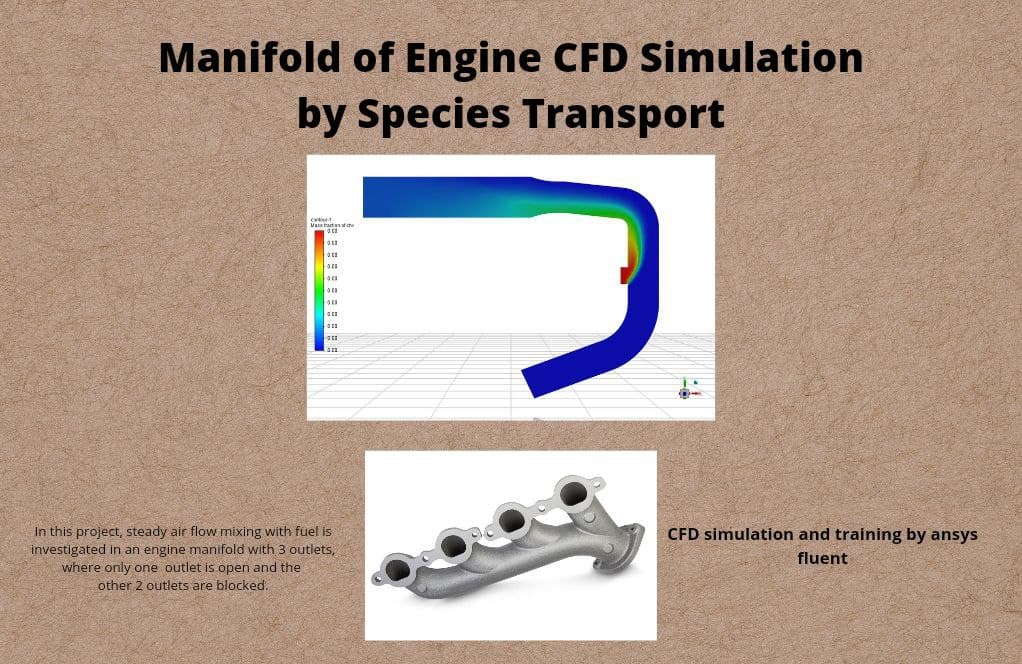


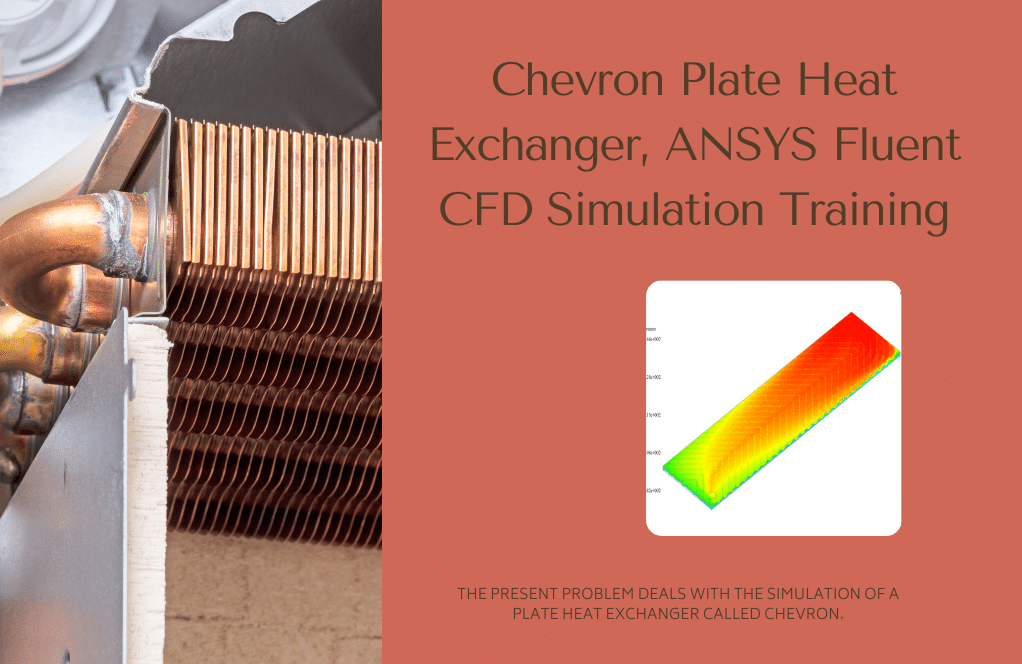
Dr. Chris Turner DVM –
I fully enjoyed the Species Transport Training Package for beginners. The variety of projects offered a comprehensive learning experience and the transition from beginner exercises to more complex scenarios was well structured. I am particularly impressed by the real-world applications like urban pollution modeling and combustion chamber analysis. This package provides a solid foundation for anyone new to ANSYS Fluent and the Species Transport module.
MR CFD Support –
We’re delighted to hear that you appreciate the thoroughness and variety of our Species Transport Training Package, Beginner Part 1. It’s rewarding to know that our content has contributed considerably to your understanding. Thank you for your positive feedback, and we look forward to providing you with continuous support in your learning journey.
Domingo Ondricka III –
I absolutely enjoyed working with the Species Transport Training Package for Beginners! Each exercise felt perfectly calibrated to enhance my understanding in a gradual yet challenging way. The examples provided a variety of scenarios which expanded my grasp on the application of ANSYS Fluent in environmental and industrial contexts. Well-structured and immensely valuable!
MR CFD Support –
Thank you so much for your positive feedback! We’re thrilled to hear that you found our Species Transport Training Package for Beginners both challenging and informative. It’s great to know that the exercises helped in improving your skills in ANSYS Fluent. Your success is what drives us to create these comprehensive learning materials. Keep up the great work!
Pearlie Bechtelar –
I’m getting started with CFD, and this training package seems a good fit. How does it cater to absolute beginners, especially in explaining the setup and interpretation of results?
MR CFD Support –
Our ‘Species Transport Training Package, Beginner Part 1’ is tailor-made for beginners. It provides step-by-step instructions in each of the 10 exercises to help you understand the fundamental concepts of species transport and CFD simulation with ANSYS Fluent. The package includes detailed guides on setting up boundary conditions, solving setups, and interpreting results with plenty of visual aid to ensure comprehensive learning. You’ll start with simpler simulations and gradually progress to more complex ones throughout the exercises. Moreover, our team is always ready to assist if you need any support.
Dora Pagac –
I recently completed the Species Transport Training Package, Beginner Part 1, and I had an insightful experience getting hands-on with CFD. The diversity of projects, from urban pollution to combustion in gas turbines, gave me a broad view of species transport applications. I particularly appreciated the step-by-step guidance in ANSYS Fluent, which helped me gain confidence in performing complex simulations. Not to mention, the project on non-premixed combustion was fascinating and the ventilation simulation in an operating room was an excellent real-world scenario that illustrated the importance of CFD in safety and design.
MR CFD Support –
We’re thrilled to hear that you had a positive learning experience with our Species Transport Training Package for BEGINNERS! It’s great to know that the variety of projects enabled you to understand the wide applications of species transport simulations. We’re glad that our step-by-step guidance was effective and appreciate you highlighting the non-premixed combustion and ventilation studies. Thank you for taking the time to share your feedback, and congratulations on completing the training! Keep up the excellent work as you continue to explore the world of computational fluid dynamics.
Ms. Rosalinda Dibbert MD –
I finished the Beginner Part 1 Species Transport Training, which was insightful! Loved the step-by-step guidance in project 5 on methane-air fuel mixture combustion. How do I make sure I set up the species mass fractions correctly for Project 10 in my simulation?
MR CFD Support –
Thank you so much for your positive review! I’m thrilled to hear that the training helped you. Regarding Project 10’s species mass fractions set up, you want to ensure that the total mass fraction adds up to 1. Entering the Species Model settings in ANSYS Fluent, you can define the individual species’ mass fractions at each inlet as given by the domain conditions, ensuring that for each inlet, their mass fractions add up to 1. Remember to apply these settings for both air and fuel inlets respectively. If you need any further assistance, do not hesitate to ask!
Prof. Luigi Nicolas I –
I’ve completed the beginner part 1 training of the Species Transport package, and I’m impressed with the diversity of practical exercises. It offered a great foundation with applications ranging from simple airflow in urban streets to complex combustion chamber simulations. Being able to see the various applications of species transport, especially in the context of pollution modeling and HVAC systems, has really solidified my understanding of the principles.
MR CFD Support –
Thank you so much for your kind words! We’re thrilled to hear that our Species Transport training package has helped to solidify your understanding in such a diverse range of applications. At MR CFD, we take great pride in developing inclusive learning materials that provide practical experience for our learners. Your feedback is invaluable, and we hope you continue to explore more advanced simulations with us in the future!
Shea Fisher –
I’m thrilled with the vast variety of practical exercises included in the Species Transport Training Package for beginners! Grasping the essentials of species transport in varied scenarios undoubtedly enhances one’s understanding of the subject and familiarity with ANSYS Fluent’s capabilities.
MR CFD Support –
Thank you for your positive feedback! We’re delighted to hear that you’re satisfied with our training package and finding it helpful in understanding the species transport phenomena using ANSYS Fluent. Your encouragement motivates us to continue delivering comprehensive learning experiences to our customers. If there’s anything more you’d like to learn or delve into, please feel free to reach out.
Bell Gleichner –
Fantastic collection of Species Transport projects for beginners! As someone new to ANSYS Fluent, these exercises have helped me understand key concepts in a hands-on way. The various examples, from urban pollution to gas turbine combustion, covered a wide range of scenarios and built a solid foundation for my further study. Really enjoyed the thoughtful setup and detailed instructions in each project!
MR CFD Support –
Thank you for taking the time to review our Species Transport Training Package for beginners. We’re delighted to hear that the exercises have been beneficial to your learning and have provided a good variety of scenarios. We appreciate your positive feedback and are always here to support you in your journey to mastering ANSYS Fluent. Keep enjoying the learning materials, and don’t hesitate to reach out if you need any assistance!
Jared Littel –
Just completed the Beginner Part 1 of the Species Transport CFD Simulation Training Package. The practical approach, especially in cases like urban pollution and the combustion process simulations, provided hands-on experience that was incredibly beneficial. The transition from theory to application was seamless, and the detailed setup for various projects like the diesel fuel combustion chamber helped in understanding complex real-world phenomena. A round of applause for the MR CFD team for curating such an informative and well-structured learning package.
MR CFD Support –
Thank you so much for your positive feedback! We’re overjoyed to hear how much our Species Transport Training Package has helped you. At MR CFD, we strive to offer comprehensive and practical learning experiences that empower our clients. Your commendation is certainly appreciated, and we’re thrilled that you found the progression from theory to practical application to be seamless. If you have any further insights or need assistance as you advance in your learning, do not hesitate to reach out!
Angela Prohaska –
I’ve just finished working through the beginner species transport training package by MR CFD, and the variety and comprehensiveness of the practical exercises provided a great introduction to ANSYS Fluent’s capabilities. Every exercise brought a new aspect to light, reinforcing my understanding of species transport phenomena. The step-by-step guidance in each project was especially helpful!
MR CFD Support –
Thank you for your kind words! We’re thrilled to hear that our beginner species transport training package met your needs and helped you gain a better understanding of using ANSYS Fluent. It’s our goal to provide detailed and varied examples to make the learning experience as effective as possible. We appreciate your review and are glad to have been a part of your learning journey!
Michale Will IV –
I just completed the beginner part 1 species transport training package and found the projects insightful for understanding the real-world scenarios of pollution and combustion! Kudos to the MR CFD Company for such a well-structured and comprehensive set of exercises. They really helped me get a good grasp of the fundamentals.
MR CFD Support –
We are thrilled to hear that you found our Species Transport Training Package so beneficial to your understanding of species transport phenomena! Thank you for such a wonderful review, and we are glad it has set a solid foundation for you. We look forward to assisting you further in your CFD journey!
Barton Beier –
The Species Transport training was absolutely insightful! As a beginner, the step-by-step guides in each practical exercise led to a fluent understanding (pun intended!) of complex processes and definitely boosted my confidence. Can’t wait to tackle more advanced simulations!
MR CFD Support –
Thank you for your positive feedback! We’re thrilled to hear that our Species Transport Training Package for Beginners has helped enhance your understanding and build your confidence. We look forward to supporting you in your journey to more advanced simulations with ANSYS Fluent. Feel free to reach out if you need further guidance or resources.
Rudolph Auer –
I recently got started on the Species Transport Training Package, and it has been quite beneficial thus far. I particularly appreciated the hands-on approach in the exercises, which allowed me to immediately apply the theory I’ve learned. The step-by-step instructions do indeed make it beginner-friendly. After going through the projects, I noticed a considerable improvement in my understanding of the subject. Thank you for putting together such a comprehensive and easy-to-follow package! Your detailed real-world examples have and continue to deepen my grasp of the theory behind species transport phenomenally.
MR CFD Support –
Thank you for your kind words! We’re delighted to hear that our Species Transport Training Package for Beginners has been helpful to you. It’s our goal to make complex subjects accessible and applicable for learners like you, and we’re thrilled that our hands-on exercises are fulfilling that purpose. If you have any questions or need further assistance, please don’t hesitate to reach out to us. Happy learning!
Watson Krajcik –
I recently purchased the Species Transport Training Package for beginners, and I must say the step-by-step guidance through the various exercises provided a solid foundation in understanding species transport phenomena in ANSYS Fluent. The variety of case studies, from urban pollution to combustion in gas turbines, enriched the learning experience. The clarity of instructions and explanations for each scenario allowed me to confidently apply the principles learned to the projects. I especially appreciated the real-world applications presented, which helped me grasp the significance of this simulation technology in addressing environmental and engineering challenges.
MR CFD Support –
We are thrilled to receive your positive feedback on our Species Transport Training Package for beginners! It is our goal to offer comprehensive and practical learning experiences that enable users like you to understand and utilize simulation technology effectively. Knowing that the variety of case studies and clear instructions helped enhance your understanding and confidence in applying species transport simulations is incredibly rewarding. Thank you for choosing our training package, and we are here to support you in your journey to mastering ANSYS Fluent.
Hermina Buckridge –
I completed the Beginner Part 1 Species Transport training package and found Project number 6 especially impressive. Simulating diesel fuel combustion in a gas turbine showed me how a diffuser duct with blades can effectively mix the fuel with disturbed airflow for better combustion. This aspect of fluid dynamics is well-explained, stepping into useful practical CFD applications for engineering.
MR CFD Support –
Thank you so much for your positive feedback! We’re glad to hear that Project number 6 on diesel fuel combustion in a gas turbine was particularly enlightening for you. Your understanding and appreciation of the mixing process in the combustion chamber validates the effort we put into our training materials. If you have any more questions or need further assistance with your CFD journey, feel free to reach out. Happy simulating!
Darius Grady –
I thoroughly enjoyed the Species Transport Training Package for beginners by MR CFD. It provided a comprehensive, step-by-step approach to learning with practical examples. The simulations ranged from urban pollution to complex combustion processes, giving a wide scope of applications. I especially appreciated the variation of scenarios that allowed me to understand the implications of species transport in different contexts.
MR CFD Support –
Thank you for sharing your positive experience with our Species Transport Training Package for beginners. We’re glad to hear that the range of scenarios and the step-by-step guidance were helpful to your learning process. It’s great to know that the package met your expectations and provided you with a comprehensive understanding of species transport in ANSYS Fluent. We appreciate your support and wish you continued success in your CFD endeavors!
Orion Hickle –
The Species Transport Training Package provided foundational knowledge and engaging practice for initiating my journey into CFD simulations using ANSYS Fluent. From understanding CO2 distribution in urban setups to investigating complex combustion reactions and HVAC systems, the variety of exercises ensured a balanced and hands-on learning experience. Huge thanks to MR CFD for this Beginner-friendly package!
MR CFD Support –
We’re delighted to hear such positive feedback and that you found the Species Transport Training Package helpful and beginner-friendly. MR CFD is committed to providing comprehensive training for users at all levels. Thank you for choosing our products for your learning journey into CFD simulations. Keep exploring and learning!
Donna Halvorson –
The Species Transport Training Package sounds comprehensive. Can you explain a bit more about the learning outcomes from Project Number 5? Specifically, how does this project help in understanding the combustion inside a gas turbine?
MR CFD Support –
The learning outcomes from Project Number 5 focus on the practical simulation of the combustion process inside a gas turbine. You’ll learn to set up initial boundary conditions for fuel and oxidizer inlets, apply the appropriate species transport and energy models to capture the combustion physics, and analyze the results to understand temperature distribution, and species concentration within the combustion chamber. This project helps in comprehending how different factors like injection velocity, temperature, and mixing affect combustion efficiency and pollutant formation.
Elias Dietrich –
The Species Transport Training Package from MR CFD was an amazing learning tool. As a beginner in CFD, I found the step-by-step guidance through the various exercises, especially the one simulating diesel fuel combustion in a gas turbine, to be excellent! Clear explanations and relevant examples have significantly boosted my confidence in using ANSYS Fluent for species transport problems.
MR CFD Support –
Thank you for the positive feedback! We are thrilled to hear that our training package was helpful in boosting your understanding and confidence in working with species transport simulations in ANSYS Fluent. If you ever have any further questions or need advanced training materials, feel free to reach out. Happy simulating!
Chasity Stoltenberg –
I’ve finished the beginner part 1 of the Species Transport training package and it was great in teaching the basics. The way the exercises incrementally build upon each other helped me establish a solid understanding. Thanks!
MR CFD Support –
Thank you for your kind words! We’re thrilled to hear that our Species Transport training package for beginners met your expectations and helped you build a strong foundational understanding. We aim to craft our exercises to be instructive and build progressively, and it’s great to know it is effective. If you need further assistance or decide to take on more advanced simulations, we’re here to help!
Prof. Merlin Smitham –
I appreciate the variety and practicality of the exercises included. Can this training package also help with understanding the abatement of air pollution?
MR CFD Support –
Yes, the training package is designed to provide a foundational understanding of species transport phenomena, including pollution dispersion and its control, which should help you gain insights into the abatement of air pollution.
Prof. Josiane Daniel V –
I absolutely love the Species Transport Training Package for Beginners. As someone new to ANSYS Fluent, the step-by-step approach with practical exercises enhances understanding and builds a strong foundation in species transport simulations. The range of applications from environmental to combustion and HVAC is truly valuable for grasping the diverse uses of CFD in various fields.
MR CFD Support –
We’re delighted to hear that our training package met your expectations and provided a strong learning foundation! Thank you for recognizing the diversity of our exercises. Your positive feedback is greatly appreciated, and we look forward to continuing to support your learning journey in CFD with ANSYS Fluent.
Mrs. Mckayla Walsh I –
I’ve purchased the Species Transport Training Package, and after going through all the sessions, I’m truly impressed! The complexity of simulations coupled with the clear walkthroughs paved the way for a deep understanding of species transport phenomena. Especially the practical exercises, like the HVAC simulation in an operating room and the manifold in project number 10, were brilliantly executed and complemented the theory perfectly.
MR CFD Support –
We’re thrilled to hear that the Species Transport Training Package exceeded your expectations! It’s great to know the practical exercises provided valuable insights into real-world applications. Thank you for choosing MR CFD’s training materials and taking the time to share your positive experience. It’s feedback from our valued customers like you that keeps us motivated!
Dr. Ashton Feeney –
I recently completed the Species Transport Training Package for beginners and wow! The step-by-step guidance through various real-world applications of species transport was tremendously helpful. Scenario setups like urban air pollution modelling and combustion chamber analysis gave me a solid foundation in CFD. The exercises progress nicely in complexity – a great way to build confidence for a novice like me.
MR CFD Support –
Thank you so much for your positive feedback! We are thrilled to hear that our Species Transport Training Package for Beginners has been helpful for you. It’s always wonderful to learn that our customers are gaining confidence and skills from our trainings. Feel free to reach out if you need further assistance or information on our other training modules. Your success in learning is our top priority!
Laverne Greenholt PhD –
I’m very impressed with the comprehensive Species Transport Training Package for BEGINNER Users. These exercises seem very involving and practical, especially enjoying the real-world relevance, like the simulation of CO2 pollution on an urban street and the effects of an oil tank detonation. Marvelous work in putting together exercises that give a hands-on understanding of species transport phenomena!
MR CFD Support –
We appreciate your kind words and are thrilled to hear that you’re finding the Species Transport Training Package engaging and practical. It’s our goal to provide real-world relevant simulations to facilitate hands-on learning. Thank you for taking the time to share your positive experience!
Cooper Sanford –
The Species Transport Training Package has truly been a game-changer for my understanding of CFD simulations! I was completely new to ANSYS Fluent’s Species Transport module, yet with these 10 practical exercises, I’ve gained a solid foundation. The progression from simple to more complex scenarios helped me grasp fundamental concepts and gradually tackle the challenges of simulating chemical species in various environments. Especially the pollutant dispersion and combustion cases offered insightful exposure to real-world applications. Hats off to MR CFD for making such a comprehensive beginner’s guide!
MR CFD Support –
We’re thrilled to hear that the Species Transport Training Package has been so beneficial to your learning experience. At MR CFD, we strive to create comprehensive materials that cater to all skill levels, especially beginners like you. Thank you for taking the time to share your positive feedback. It’s always rewarding to know our products help our users gain the proficiency they desire in CFD simulation. Keep up the great work, and we look forward to continuing to support your learning journey!
Kattie Bogan –
I’ve gone through the training for Project number 2, but I feel unclear about one aspect. How exactly are the location and characteristics of the source in the simulation defined to represent the oil tank explosion?
MR CFD Support –
To model the oil tank explosion in the simulation, the source is defined by specifying its geometric location within the domain and by setting up the initial conditions that represent the explosion. Pollutants such as carbon dioxide are released at a predefined rate and with specific temperature values associated with the combustion event resulting from the explosion.
Mitchel Senger –
I recently completed the Beginners Species Transport simulation package with the 10 practical exercises, and it was an absolute eye-opener! Tacking varied real-world pollution scenarios has given me a solid framework on species transport phenomena and its vital role in environmental modeling. The car exhaust and urban CO2 impact, in particular, was a highlight, as it felt directly applicable to modern urban planning and public health. Thanks, MR CFD, for structuring this curriculum in a way that’s engaging and profoundly educational!
MR CFD Support –
Thank you for taking the time to provide your positive feedback! We’re glad to hear that our Species Transport training package for beginners was both informative and applicable to real-life scenarios. It’s always rewarding to learn that our effort to create detailed and varied exercises is appreciated and helps our users develop a deeper understanding of CFD applications in environmental modeling. If you ever have any more questions or need further assistance as you continue your CFD journey, don’t hesitate to reach out!
Loraine Brown Sr. –
This training package was an amazing stepping stone into species transport simulations with ANSYS Fluent! The projects were thoughtfully planned; beginning with a simple urban pollution model and progressively involving more complex scenarios like oil tank explosions and ventilation systems. I really appreciate the detail given to setting up different boundary conditions and the consideration of real-world applications. Being a beginner, I especially profited from Project 5, which really illuminated how methane-air fuel combustion works in a turbine chamber. The projects spurred my curiosity and enhanced my understanding tremendously.
MR CFD Support –
Thank you so much for your positive feedback! We are thrilled to hear that the Species Transport training package has significantly contributed to your learning journey. Your grasp of the content and your detailed understanding of each project are exactly the signs of a dedicated learner. Keep that curiosity burning and don’t hesitate to reach out if you ever require further learning materials or support. Your achievements are what drive us!
Mason Luettgen –
Hats off to MR CFD for crafting such a thorough and user-friendly beginner’s package! I appreciated Project 5 with the methane-air fuel mixture simulation as it was quite pivotal for understanding the complexities of combustion within a gas turbine chamber. This experience has not only piqued my interest in combustion models but also solidified my confidence in using ANSYS Fluent for such detailed simulation tasks.
MR CFD Support –
Thank you so much for taking the time to leave such a wonderful review. We are thrilled to hear that the Species Transport Training Package met your expectations and was instrumental in enhancing your understanding of combustion processes in gas turbine chambers. If you ever have any more feedback or need further assistance, remember that our team is here to help you. Best of luck on your continuing journey with ANSYS Fluent simulations!
Mariam Rosenbaum V –
Would the Species Transport Training Package be beneficial for someone interested in environmental engineering, and can it also cover topics outside of air pollution like water quality simulations?
MR CFD Support –
Yes, the Species Transport Training Package is certainly beneficial for someone in environmental engineering as it offers practical exercises related to air pollution and the dispersion of pollutants which are key areas in environmental studies. While this package focuses primarily on air pollution, the principles learned can be extended to other applications such as water quality simulations, as the fundamental concepts of species transport are similar across different mediums.
Velva Fisher PhD –
I found the examples covering urban pollution, combustion reactions, oil tank detonation, and ventilation systems in the Species Transport Training Package incredibly detailed and informative. Can’t wait to apply these concepts to real-world engineering problems!
MR CFD Support –
Thank you for your positive feedback! We’re thrilled to hear that you found our Species Transport Training Package comprehensive and useful for practical application. If you ever have any questions or need further assistance with your simulations, please don’t hesitate to reach out. Your success is our top priority!
Alycia Marks –
I’m impressed with the diversity of practical exercises offered in the Species Transport Training Package for beginners. I’ve completed several simulations, and the step-by-step instructions have been great for understanding the concepts of pollution dispersion and combustion effects.
MR CFD Support –
We’re thrilled to hear that you’ve had a positive experience with our Species Transport Training Package and have found the simulations beneficial to your learning journey. Thank you for choosing MR CFD’s learning products, and we look forward to supporting you further in your understanding of CFD analysis in ANSYS Fluent.
Genoveva Pagac –
The Species Transport Training Package was fantastic for an introduction to simulations! The range of exercises provided a solid foundation and each project built upon the last in both complexity and the skills required. I learned a lot and felt more confident after completing the detailed exercises in pollution, combustion, and ventilation scenarios – all relevant to real-world applications.
MR CFD Support –
Thank you so much for sharing your experience! We’re thrilled to hear that the training package met your expectations and helped you build a solid foundation in Species Transport simulations with ANSYS Fluent. Your confidence and skills growth are exactly what we aim for. If you have any more feedback or need further assistance as you continue learning, please let us know!
Kristina Botsford –
The Species Transport Training Package seems incredibly thorough. Each project appears to build upon the last, helping newcomers progressively understand the complexities of ANSYS Fluent’s Species Transport simulations. I appreciate the variety of applications covered, from urban pollution to internal combustion and HVAC systems. MR CFD has done an excellent job crafting a learning path that mirrors the challenges faced by professionals in the field.
MR CFD Support –
Thank you for the fantastic feedback! We are delighted to hear that the progression and practical applications within our Beginners Species Transport Training Package met your expectations and were instrumental in enhancing your understanding of ANSYS Fluent’s capabilities. At MR CFD, we aim to provide an immersive learning experience that closely aligns with real-world scenarios. Your satisfaction validates our efforts, and we look forward to supporting your continued learning journey in CFD.
Hailey McClure II –
I recently finished the ‘Species Transport Training Package, Beginner Part 1’ and I have to say as someone new to ANSYS Fluent, I found the practical exercises particularly helpful. The way each project built upon the last really solidified my understanding of species transport and its real-world applications, like the spread of pollutants. The range of scenarios, from combustion processes to simulation of airflow effects on CO2 in an urban street, was broad and interesting. I appreciated the detailed explanation and setup process for each exercise, which made it easier for me to follow along. Thanks for putting together such an educational and well-organized package for beginners!
MR CFD Support –
Thank you for your kind words and positive feedback! We’re thrilled to hear that the ‘Species Transport Training Package, Beginner Part 1’ met your needs and helped you gain a solid understanding of species transport applications in ANSYS Fluent. At MR CFD, we strive to provide learning materials that help demystify complex concepts and make learning accessible to all skill levels. Your success is a testament to our commitment. If you have any further questions or need assistance as you continue to explore CFD simulations, don’t hesitate to reach out!
Prof. Reina Wiegand DDS –
The practical exercises contained within the Species Transport Training Package for beginners helped solidify my understanding of ANSYS Fluent’s capabilities to simulate various scenarios, from urban pollution to combustion chambers. Each exercise built upon the previous one, methodically enhancing my skills. High marks for the comprehensiveness and depth!
MR CFD Support –
We’re absolutely delighted to hear that our Species Transport Training Package has helped enhance your understanding and skills in using ANSYS Fluent. Your feedback is greatly appreciated, and we are glad you found the exercises both comprehensive and educational. Thank you for choosing MR CFD and taking the time to leave a positive review!
Prof. Adonis Bahringer –
I want to learn about spacing in species transport simulations. In the training package, how is the grid-dependent study approached throughout different projects?
MR CFD Support –
Within the Species Transport beginner training package, attention is given to the importance of meshing and grid-independent studies. Each project starts with a basic mesh to understand the initial flow and pollutant distribution. As learners progress, refinements are made to regions of interest such as pollutant sources or reaction zones. This step-by-step refinement guides users through understanding how the grid influences the simulation results and leads to a grid-independent solution for accurate analysis.
Brandt Cole –
This package was fantastic as a starting point in CFD! The variety of projects created a solid foundation for understanding species transport phenomena. Wondering, is there any project that involves more complex chemical reactions like combustion of biodiesel in engines?
MR CFD Support –
We’re delighted to hear that you found the training package to be helpful! Currently, the package focuses on projects, including typical fossil fuels and standard combustion processes. We will consider adding a project involving biodiesel combustion to provide insights into renewable fuels for future updates. We always strive to keep our material relevant and up-to-date with the latest industry trends. Thank you for your input—it’s suggestions like yours that help us improve!
Ada Fritsch –
I found the Beginner Part 1 of the Species Transport Training Package extremely helpful. The step-by-step approach made it easy to understand complex concepts, particularly how species interactions are simulated in urban environments.
MR CFD Support –
We’re thrilled to hear that you found our Species Transport Training Package for Beginners helpful! We always aim to provide clear and in-depth explanations to make complex CFD topics easy to understand for all levels, including beginners. Thank you for sharing your positive experience—it’s greatly appreciated!